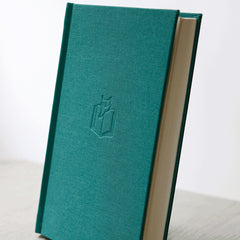John Moore
The 34th Slightly Foxed Edition is in, Brensham Village by John Moore and we thought it was a great opportunity to have a look at two of his books that they have republished in their charming cloth bound limited editions.
I have written a book which gives me much pleasure. It is a kind of full-length portrait of a small country town between the wars. The sort of life that will never come back,’ John Moore wrote to T. H. White in the summer of 1945.
The book was Portrait of Elmbury, the first volume in a trilogy based on Moore’s home town. Born in 1907, he grew up in Tewkesbury at a time when such small English market towns still had a distinct and sturdy life of their own. Mass travel, mass media and the changes brought about by two world wars would gradually destroy this self-contained rural society, but in this book Moore caught and preserved it in captivating detail.
 Portrait is by no means sentimental. Moore’s family home, ‘the loveliest house in Elmbury . . . looked across a wide main street upon the filthiest slum I have ever set eyes on’. This was Double Alley, whose wild and drunken inhabitants were part of Moore’s growing-up, as were a large cast of rugged individuals including his schoolmaster Mr Chorlton, who taught him about Greek verse and Lepidoptera; the duck-shooting, whisky-drinking local colonel with his ‘badger-grizzled walrus moustache’ and pulsating red nose; and Miss Benedict, the disapproving barmaid at one of the town’s 28 pubs.
Portrait is by no means sentimental. Moore’s family home, ‘the loveliest house in Elmbury . . . looked across a wide main street upon the filthiest slum I have ever set eyes on’. This was Double Alley, whose wild and drunken inhabitants were part of Moore’s growing-up, as were a large cast of rugged individuals including his schoolmaster Mr Chorlton, who taught him about Greek verse and Lepidoptera; the duck-shooting, whisky-drinking local colonel with his ‘badger-grizzled walrus moustache’ and pulsating red nose; and Miss Benedict, the disapproving barmaid at one of the town’s 28 pubs.
Though it may be unsentimental, Moore’s picture of Elmbury, with its surrounding farms and orchards, its river meadows and great Romanesque abbey, is a joyful hymn to the fullness and variety of small-town life. Moore later became a journalist, wrote many books and spent some time in London, where he found the inhabitants of Bloomsbury ‘as conventional as the heroes and heroines of their novels’. But he always returned to Tewkesbury, where somehow ‘emotions seemed larger, pleasures were keener, sorrows sharper, the tragedy more profound and the comedy more riotous’. In Portrait of Elmbury he left a wonderful account of that vanished world – of a ‘life that will never come back’.
‘Mr Moore has written a very good book. It has vivid characterization, country lore, humour and fine commonsense. It is true to the real heart of England,’ declared the Daily Telegraph in 1945 of John Moore’s Portrait of Elmbury . . .
To buy a copy click here.
The same could certainly be said of Brensham Village, its sequel, which was published a year later. Like its predecessor, Brensham Village is a lightly disguised picture of a part of England Moore knew well: the countryside surrounding the old market town of  Tewkesbury, which Moore calls Elmbury, where he was born in 1907 – a lush and fertile area of market gardens and apple orchards, with the river Severn winding through. Brensham, Moore tells us, is a synthesis of several villages whose fields he roamed as a boy and whose pubs he drank in as a young man. In Portrait of Elmbury (SFE no. 26) he drew a vivid picture of growing up in a colourful and self-sufficient English country town in the years after the First World War. InBrensham Village, set in the 1930s, change is creeping in. There is still cricket on the village green and darts in the village pub, Moore and his friends still go fishing and ferreting and bird’s-nesting and hunting for moths. But mannerless weekenders are beginning to arrive in the village, along with a shady ‘Syndicate’ of developers, an ugly petrol station and a local cinema.
Tewkesbury, which Moore calls Elmbury, where he was born in 1907 – a lush and fertile area of market gardens and apple orchards, with the river Severn winding through. Brensham, Moore tells us, is a synthesis of several villages whose fields he roamed as a boy and whose pubs he drank in as a young man. In Portrait of Elmbury (SFE no. 26) he drew a vivid picture of growing up in a colourful and self-sufficient English country town in the years after the First World War. InBrensham Village, set in the 1930s, change is creeping in. There is still cricket on the village green and darts in the village pub, Moore and his friends still go fishing and ferreting and bird’s-nesting and hunting for moths. But mannerless weekenders are beginning to arrive in the village, along with a shady ‘Syndicate’ of developers, an ugly petrol station and a local cinema.
Some of the same characters who appeared in Elmbury are still going strong – Mr Chorlton, Moore’s polymathic bachelor Classics master; the sporting whisky-sodden old Colonel, hung about with guns and salmon rods; the trio of rogues Moore christens Pistol, Bardolph and Nym, plus a whole new cast of villagers – market-gardeners, farmers, barmaids, members of the cricket team – watched over by shabby, gentle Lord Orris in his crumbling, mortgaged manor. These were the last shadows of an England that was on the very point of vanishing – ‘a world’, as John Moore wrote to T. H. White, ‘that will never come back’, but one that he captured brilliantly for ever.
To buy a copy click here.
